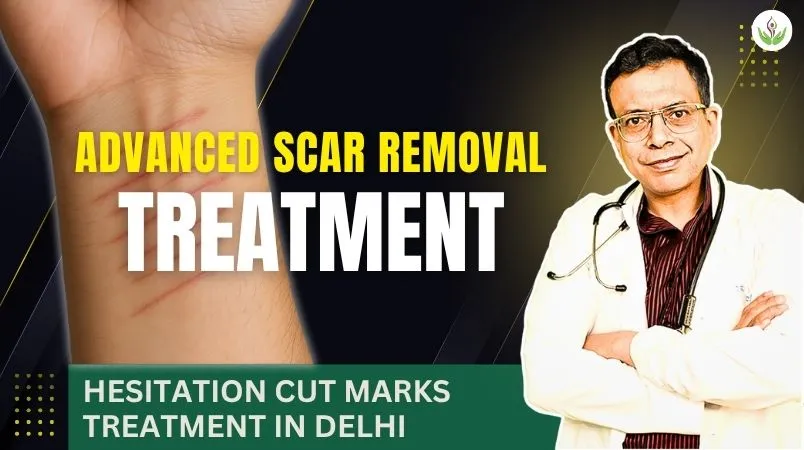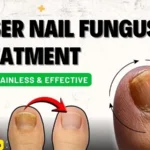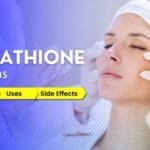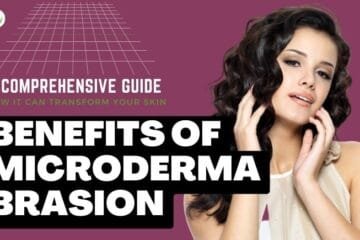I often meet many people at my clinic in Delhi who try to hide something by pulling down their sleeves. When they finally show me, I notice straight, thin lines on the wrist or forearm — these are hesitation cut marks. Over the years, I have treated many patients seeking hesitation cut marks treatment in Delhi, because these scars are not just on the skin. They carry memories, emotions, and pain from the past.
I know these scars are not just on the skin — they carry memories, emotions, even pain from the past. And most patients ask me the same question, “Doctor, will these marks ever go away?”
The good news is, with today’s advanced treatments, we can soften and lighten these scars. My role as your doctor is not just to treat the skin, but to also help you feel comfortable in it again.
What Are Hesitation Cut Marks?
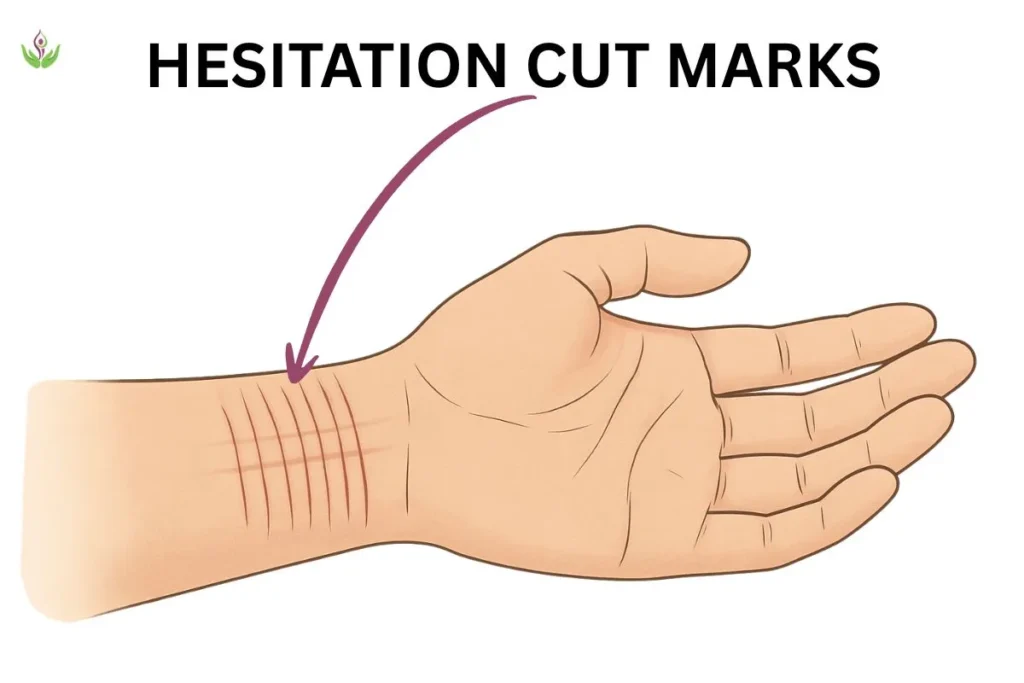
I don’t just notice scars when a patient comes into my clinic with hesitation cut marks. I also see how bad they feel hiding their hands and the nervous glance they make before showing me their wrists and becoming silent afterward. These marks no longer stay deep on the skin alone; they are a painful reminder of indescribable emotions, memories, and stories.
I often hear patients quietly telling me, “Doctor, I can’t explain these lines repeatedly to people,” expressing their utter frustration over hesitation cut marks. I just want them to fade.” That one sentence says it all — the desire to move forward without reminders of a difficult past.
Why these scars form and their unique patterns
Hesitation cut marks don’t behave like accidental wounds. They are usually caused by repeated, shallow cuts in the same spot. That’s why they appear as:
- Thin and straight lines, often running parallel.
- Flat, pale, or darker streaks that remain unmatched with the surrounding skin.
- Stubborn scars that don’t usually fade with time, regardless of the number of creams you may try to remove them.
Just consider that you are in front of the mirror, watching the same lines every day. That’s what many of my patients describe — a feeling of being stuck with scars that never seem to change.
Common areas affected (wrist, forearm, hand)
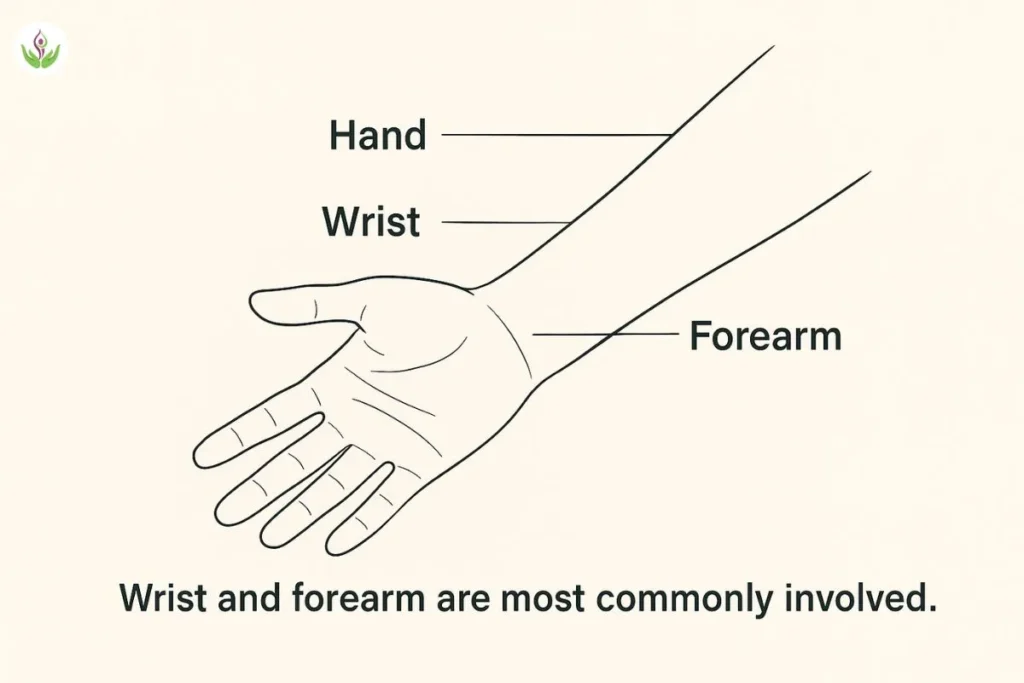
Usually found on wrists and forearms, these marks also appear sometimes on hands. These areas will have thin skin that is constantly moving and with very little fat within. As a result, scars become increasingly noticeable and harder to hide.
Once, I treated a young man who didn’t wear a short-sleeved shirt for many years, as he was apprehensive of someone potentially noticing his wrist. Another patient recounted wearing a watch slightly higher to cover the marks, not for fashion.
Such small details reveal how much impact hesitation cut marks can have on daily life. They no longer remain a cosmetic issue; they dampen confidence, relationships, and make one feel uncomfortable in their own skin.
If you seek my opinion, an effective treatment for this starts by understanding this reality. Because healing hesitation cut marks is not only about improving the skin’s surface — it’s about helping you feel free, at ease, and ready to move forward.
Can Hesitation Cut Marks Be Removed Permanently?
Patients often sit beside me and quietly ask, “Doctor, will I ever see a day free of these scars?” I can understand the pain and emotion behind that question. It does not only represent the skin, it also reflects memories, confidence, and the will to move on.
However, I always reveal one truth: so far, no treatment has been discovered to completely erase scars. You, however, shouldn’t be hopeless. Yes, using the right approach can help these marks fade to such a great extent that many people can’t even notice. And that change often feels like freedom.
Myths vs facts about scar removal
Over the years, I’ve heard many myths. Some patients tell me they spent months using a cream that promised to “remove scars forever.” Others believed one laser session would make the marks disappear.
The facts are different:
- Creams can soften skin, but they cannot repair old, deep scars.
- One or two laser sessions are rarely enough for hesitation cuts.
- Real results come when we combine therapies that target both texture and color.
I often see a sense of relief when patients finally hear this. They say, “At least now I know what’s real.”
What results you can realistically expect
With advanced treatments — CO2 fractional lasers, MNRF, dermabrasion, grafting, and pigmentation correction — results can be remarkable.
Most of my patients notice:
- The scars become lighter and closer to their natural skin shade.
- Lines that once stood out start blending with the surrounding skin.
- The mirror no longer feels like an enemy.
One young woman told me after her sessions, “For the first time in years, I wore a short-sleeved dress without feeling anxious.” That is the kind of change you can expect — not perfection, but freedom.
In most cases, scars reduce by 60–80%. If you look closely, faint lines may still be there, but in everyday life, they no longer define you. And that, for many patients, is the real victory.
Why Single Treatments Often Fail
When patients come to me after trying creams or a few laser sessions elsewhere, they often say with frustration, “Doctor, nothing seems to work.” I nod because I understand why — hesitation cut marks are stubborn, and rarely improve with one treatment alone.
Limitations of only creams or silicone gels
I’ve seen countless drawers filled with half-used scar creams. Patients try them faithfully, hoping each new tube will finally work. While some creams can lessen redness or soften fresh scars, old and patterned scars can’t be healed with creams. They cannot restore lost collagen or color.
I usually tell them gently,” It hasn’t happened due to your fault. These products were simply never designed for scars like yours.” And most patients feel a strange comfort in hearing that.
Why lasers or dermabrasion alone may not be enough
Lasers and dermabrasion are powerful tools, and I use them often. A CO2 fractional laser can resurface skin, while dermabrasion smooths roughness. But on their own, they usually give only partial results.
- While lasers may lighten scars, they fail to lift depressed lines all the time.
- On the other hand, dermabrasion is capable of polishing the surface. However, it fails to restore natural pigmentation.
This is precisely why I don’t depend on them alone. Instead, I combine them with micro-skin grafting, fat grafting, and melanocyte transplantation. This way, we target not just the surface, but also the depth, the volume, and the skin color.
One of my patients once told me, “Doctor, after trying everything, your combination approach finally gave me hope.” That is exactly why single treatments often fail, and why a multi-step plan makes all the difference.
Modern Treatment Options for Hesitation Cut Marks
Whenever I meet a new patient, I like to sit down and explain every option patiently. I’ve seen that when people understand how each treatment works, they feel calmer and more hopeful. Let me take you through the methods I commonly use for hesitation cut marks, in the same way I explain to my patients in the clinic.
Topical creams and silicone gels
Almost everyone who comes to me has already tried creams. Some even show me drawers filled with half-used tubes. A few creams and silicone gels do help in the early stages — they can soften scars or reduce redness. But for old hesitation cut marks, they rarely make a big difference.
Sometimes I still prescribe them, not as a “cure,” but as part of a broader plan. They keep the skin hydrated and prepare it for advanced treatments. I usually tell patients gently, “These are helpers, not heroes.”
CO2 fractional laser for scars
The CO2 fractional laser treatment is one of my most trusted tools. It works by creating tiny controlled injuries in the skin, which trigger natural healing and collagen growth. Over time, this softens the scar lines and improves the overall texture.
One of my patients told me after her second session, “Doctor, for the first time, my skin feels smoother when I touch it.” Hearing that gives me as much joy as the patient feels.
MNRF (Microneedling Radiofrequency)
MNRF is a powerful technique for deeper scars. It incorporates tiny needles that penetrate into the skin while emitting radiofrequency energy. This integration helps repair the skin’s inner layers and simultaneously tighten it.
For hesitation cut marks that are indented or depressed, Microneedling Radiofrequency (MNRF) can bring visible improvement. I often combine it with a CO2 laser — one works on the surface, the other on the depth. Patients usually notice not just a change they see in the mirror, but also a change they feel when running their fingers across the skin.
Chemical peels for blending
Not all scars are about depth — many are about color mismatch. Some scars look whiter than the skin, others darker. That uneven tone makes them stand out.
Such cases will have chemical peels treatment assisting in skin blending. By gently exfoliating the outer layer, these peels enable new, healthier skin. I usually tell patients, “Scars won’t go away with peels alone. However, they will even out the tone and make scars less prominent.” For many, this subtle difference translates into a massive psychological difference.
Kenacort injections for raised scars
A few hesitation cut marks don’t stay flat. They heal in a raised or thickened way, and that makes them more visible. For these, I often use tiny injections of Kenacort (a form of steroid).
When used carefully, these injections flatten the scars and soften the texture. One young man told me, “Doctor, I can finally stop feeling that bump whenever I run my finger across my wrist.” That small change brought him huge relief.
Dermabrasion – supportive role
Dermabrasion is one of the older methods, where the outer skin is polished with a controlled device. On its own, it doesn’t do enough for hesitation cut marks. But when combined with other treatments, it plays an important supportive role.
I usually describe it as “preparing the canvas.” By smoothing the surface first, later treatments like lasers or grafting often work more effectively.
Combination Techniques That Offer Better Results
Many patients come to me after trying different treatments elsewhere. They say, “Doctor, I had laser sessions, but the scars are still there,” or “Dermabrasion helped a little, but the lines never went away.” I understand their frustration.
The truth is, hesitation cut marks are not like ordinary scars. They disturb the surface, the volume, and even the color of the skin. Unless all three are addressed together, results remain incomplete.
That’s why over the years, I’ve shifted towards a combination protocol. It brings better improvement, because each step covers what the other one misses.
Micro-skin grafting – replacing scarred patches
With micro-skin grafting, I take tiny pieces of healthy skin from an area where no one will notice, and place them over the scarred patch.
I often tell patients to imagine it like planting fresh seeds in dry soil. Slowly, those new grafts blend into the skin, softening the sharp lines of hesitation marks.
One young woman once told me after her grafting healed, “Doctor, for the first time, people stopped asking me about my wrist.” That, to me, was a bigger success than the medical result alone.
Fat grafting – restoring volume and smoothness
Some scars don’t just look flat — they feel hollow when you run your fingers over them. For such cases, I use fat grafting.
I gently take a small amount of fat from another area of the body, process it, and place it beneath the scarred skin. The hollowness fills, the surface evens out, and the skin starts looking smoother.
Many patients also notice something extra: fat brings stem cells that help in natural healing. A young man once smiled at me and said, “Doctor, my wrist finally feels normal when I touch it.” That simple sentence said it all.
Melanocyte transplantation – correcting color mismatch
Another problem with hesitation cut marks is color contrast. Some scars turn too white, others look darker. Either way, they stand out.
Here, I use melanocyte transplantation — moving pigment cells into the scarred area so that it regains a more natural shade.
This is especially important for Indian skin tones, where even a small mismatch can draw unwanted attention. Patients often tell me how relieved they feel once the scar blends better with their natural color.
Why multimodal approach works best
I often explain to patients with a simple example: “If your wall has a crack, you can’t just paint over it. You need to fill the crack, smooth the surface, and then repaint it so it looks like new.”
That’s exactly how hesitation cut marks need to be treated:
- Lasers and MNRF improve texture.
- Fat grafting fills lost volume.
- Micro-skin grafting replaces damaged skin.
- Melanocyte transfer corrects color.
When all of these are done together, the scars stop being the first thing people notice. More importantly, patients stop noticing them too. And that’s when true healing begins.
Treatment Journey – Sessions, Downtime, and Safety
When someone starts treatment with me, I tell them honestly: “This is not a quick-fix cream story. It’s a process.” Scars that stayed with you for years will take time to go away. However, they become lighter and less visible with each step.
How many sessions are needed
How many sittings are required? Patients ask me this right away. My answer is always: “It depends on your skin, your scars, and how your body heals.”
- For lasers like CO2 fractional, usually 3–5 sittings.
- For MNRF, about 3–4.
- Chemical peels often need 2–4 rounds.
- Grafting (micro-skin, fat, or melanocyte) is often one-time.
Some people see a visible change after two sittings. Others take longer. I’ve seen both — and both are normal.
Recovery time and aftercare
Recovery feels different for everyone. One patient panicked on day two because her skin turned red and flaky. By day seven, she sent me a message saying, “Doctor, my skin looks fresher than ever.”
That’s recovery — a week of mild inconvenience for months of improvement.
- Lasers/MNRF: 3–7 days of redness.
- Peels: light flaking for about a week.
- Fat grafting/skin grafting: swelling that settles in 1–2 weeks.
What really matters is aftercare. Sunscreen. Moisturizer. No scratching. Following instructions strictly. The patients who listen carefully often see the best results.
Safety aspects of lasers, grafting, and injections
“Doctor, is it safe?” — I hear this question every day. My answer: Yes, when done right.
Lasers and MNRF are machine-based, but I use carefully controlled energy. Kenacort injections are powerful, but I inject in tiny, measured doses. Grafting is surgical, but with sterile protocols, risk is minimal.
I often remind patients, “Your skin is delicate. My first duty is to protect it, then to improve it.”
Cost of Hesitation Cut Marks Treatment in Delhi
Money matters. Many patients remain reluctant to ask about cost at first glance. However, I bring it up because understanding the cost is crucial to making informed decisions.
Factors affecting cost (procedure type, sessions, clinic)
Costs vary because scars vary. A patient with two small wrist lines will not need the same as someone with multiple deep marks across both forearms.
The main things that affect cost are:
- The procedure chosen (lasers, grafting, or a mix).
- The number of sessions required.
- Clinic standards and machine quality.
- The surgeon’s experience.
I tell my patients, “You are not paying only for treatment. You are paying for safe hands, proper follow-up, and results you can trust.”
Approximate price range for different methods
To give you a rough idea (Delhi standards):
- Creams or peels: The per session cost ranges around ₹3,000 – ₹6,000
- CO2 laser or MNRF: Expect the per-session cost to be around ₹8,000 – ₹15,000.
- Kenacort injections: The per-sitting cost remains around ₹2,000 – ₹5,000.
- Micro-skin grafting or melanocyte transfer: ₹35,000 – ₹60,000 (one-time)
- Fat grafting: ₹40,000 – ₹70,000
One young man told me after seeing this breakdown, “Doctor, I used to waste thousands on creams that did nothing. At least now I know what I’m investing in.”
Why combination treatments may cost more but give better outcomes
Combination approaches are more expensive, yes. But they are also more complete.
- Lasers polish texture.
- Grafts replace damaged skin.
- Fat restores volume.
- Melanocytes fix color.
Together, they solve what single methods cannot.
A young woman once hugged me after her treatment and said, “For the first time in years, I wore a sleeveless top without feeling ashamed.” At that moment, I realized — the value of confidence cannot be written on a bill.
Results You Can Expect
When patients begin treatment for hesitation cut marks, their biggest question is, “Doctor, how much will these really fade?” I always give an honest answer by saying that scars don’t vanish fully. Rather, they can soften, blend, and lose their power to affect you daily.
Before-after improvements in cut marks
I have witnessed patients smiling who used to hide their wrists with watches or long sleeves. After treatment, you can witness –
- Softening of sharp lines
- Even texture
- Effective color blending with the rest of the skin.
Once, a young woman rolled up her sleeve before me and said, “Doctor, people no longer notice my scars.” That moment said more than any medical chart.
The most common changes are:
- Texture: rough or hollow scars feel smoother under the fingers
- Color: mismatched tones look closer to the natural shade, even in sunlight
- Visibility: scars no longer grab attention at first glance
Even if faint lines remain, the mirror tells a different story — one of freedom instead of constant reminders.
How results evolve over time
Results come gradually, not overnight. I explain it like this: “Think of healing as a slow sunrise. At first it’s dim, and then one morning, you realize the whole sky is bright.”
- First few weeks: redness, flaking, or swelling. Some patients feel nervous seeing this, but it’s normal.
- 1–2 months: scars begin to soften, and the skin feels less uneven to touch.
- 3–6 months: deeper changes settle in. Collagen rebuilds, grafts integrate, and color evens out.
Many patients tell me they notice the difference most not in photos, but in small moments — catching their reflection in a shop window or running their hand across smoother skin.
Importance of patience and follow-up care
Patience is the hidden ingredient in scar treatment. Without it, results fall short. With it, they shine.
I remember a young man who nearly gave up after two sessions. “Nothing has changed,” he said. I convinced him to continue. By the fifth month, his scars had faded nearly 70%. He later admitted, “Doctor, I’m so glad I trusted the process.”
The truth is, results depend as much on aftercare as on treatment.
- Sunscreen protects new skin from darkening.
- Moisturizers keep healing smooth.
- Avoiding scratching or picking prevents fresh damage.
Those who follow these simple habits usually see the best transformations.
To conclude, scar treatment is beyond skin. It’s about getting your confidence back, demonstrated by wearing short sleeves, free handshakes, a flinch-less pose before the mirror. That’s when I know we’ve truly succeeded.
Watch Video: Best Scar Removal Treatments in Delhi
Here’s a short video where I explain the most effective scar removal options for hesitation cut marks. You’ll also see real results from my patients in Delhi.
FAQs on Hesitation Cut Marks and Treatments
Old cut marks cannot be erased fully, but they can fade 60–80% with advanced treatments like lasers, MNRF, grafting, and pigmentation correction. With the right plan, they blend naturally into surrounding skin.
Both work differently. CO2 laser improves surface texture, while MNRF repairs deeper layers. For hesitation cut marks, I often combine both for stronger, longer-lasting results instead of choosing one over the other.
Numbing cream or local anesthesia help execute most treatments. Patients often feel mild discomfort, free of pain. What’s heartening for patients is a short downtime, helping them recover smoothly, mostly.
The cost varies with treatment type. Laser or MNRF sessions start around ₹8,000. One may have to pay around ₹35,000-₹70,000 for grafting procedures. While combination treatments might raise your cost, the understandably better results make it worth investing.
No! Scars don’t usually vanish entirely. However, effective treatment can fade them greatly and be unnoticeable by most people. It’s all about natural blending, not complete removal.
Most patients need 3–5 laser or MNRF sessions. Peels require 2–4 sittings. Grafting is usually one-time. Visible change often appears after 2–3 sittings, with full results in 3–6 months.
Yes, as scars fade after effective treatment, you usually witness a long-lasting improvement. However, aftercare, lifestyle, and skin type further dictate treatment outcomes. As part of aftercare, sun protection plays a major role.
Yes. With modern lasers, MNRF, and careful settings, treatments are safe for Indian skin. I also use melanocyte transplantation where color mismatch is a concern. Safety depends on the doctor’s experience.
No. Creams may soften fresh scars or reduce redness, but old hesitation cut marks need advanced treatments like lasers, grafting, or MNRF. Home remedies cannot rebuild lost collagen or skin color.
Most patients return to normal activities within 2–3 days after lasers or peels. Grafting may need a week of rest. Makeup and full sun exposure should be avoided until healing completes.
Yes. Raised scars respond well to Kenacort injections, sometimes combined with lasers or grafting. Flat or depressed scars need other methods. Treatment is always customized to the scar type.
People who should avoid or delay scar treatments include –
1. Pregnant women
2. People with active infections
3. Those struggling with uncontrolled diabetes
4. People with certain skin ailments
So, it’s advisable to undergo a proper consultation. It ensures safety before the commencement of any procedure.
Final Thoughts
Hesitation cut marks are not easy, but they are not hopeless either. With the right mix of lasers, grafting, and supportive treatments, scars can fade enough to stop troubling your daily life.
From my experience, the best results come with a multimodal approach — treating texture, volume, and color together. It’s not about erasing scars completely, but about reclaiming confidence. With modern hesitation cut marks treatment in Delhi, patients can achieve visible improvement and finally feel free to live without constant reminders of the past.

